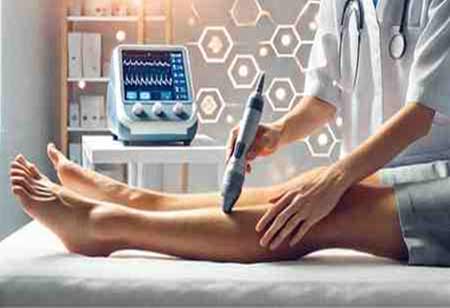Thank you for Subscribing to Healthcare Business Review Weekly Brief
Be first to read the latest tech news, Industry Leader's Insights, and CIO interviews of medium and large enterprises exclusively from Healthcare Business Review
Rethinking Varicose Veins: Health Implications and Treatment Trends
Varicose veins are becoming more recognized for their cosmetic concerns and associated health risks, such as venous insufficiency and thrombophlebitis.

By
Healthcare Business Review | Friday, March 21, 2025
Stay ahead of the industry with exclusive feature stories on the top companies, expert insights and the latest news delivered straight to your inbox. Subscribe today.
Varicose veins are becoming more recognized for their cosmetic concerns and associated health risks, such as venous insufficiency and thrombophlebitis. The landscape of varicose vein treatment has transformed considerably, driven by innovations in endovenous laser therapy, radiofrequency ablation, and sclerotherapy techniques. The evolving understanding of the pathophysiology of chronic venous disease has led to a paradigm shift in patient engagement, with an increasing emphasis on addressing treatment's functional and aesthetic outcomes.
Patients are now more aware that these veins can lead to complications such as ulcers, blood clots, and chronic pain rather than being merely a cosmetic concern. One of the critical trends is the rising demand for minimally invasive procedures. Traditional surgical methods like vein stripping are gradually being replaced by procedures such as radiofrequency ablation (RFA), endovenous laser treatment (EVLT), and sclerotherapy. These newer techniques offer patients lower risk, less discomfort, and quicker recovery times.
Consequently, what was once a hospital-centered treatment has transitioned increasingly towards outpatient services, making it easier for patients to access care quickly, often within a day. Moreover, the industry is witnessing a shift in demographics, with more men and women seeking treatment earlier in the progression of their conditions. As the stigma surrounding varicose veins decreases, patients are more inclined to prioritize their health and seek professional help, resulting in more extensive treatment options and growing demand for specialized clinics.
Technological Advancements in Varicose Vein Treatment
Technological innovations play a crucial role in the evolution of varicose vein services. One notable advancement is integrating artificial intelligence (AI) and machine learning into treatment planning and patient diagnostics. Through analyzing historical data and patient outcomes, AI can assist healthcare providers in making more informed decisions regarding treatment options, improving accuracy and effectiveness while reducing recovery times.
Advancements in diagnostic imaging techniques, including high-resolution ultrasound, have enhanced healthcare professionals' ability to assess vein health accurately. Portable diagnostic tools, in particular, allow physicians to evaluate patients outside traditional clinical settings, making it easier for those with mobility issues or those living in remote areas to receive timely diagnoses.
Telemedicine has also emerged as a game-changing technology in this sector. Virtual consultations allow healthcare providers to deliver pre-treatment evaluations and post-operative follow-ups effectively, bridging gaps in accessibility for patients who may otherwise find it challenging to reach physical clinics. This approach increases convenience and allows healthcare systems to optimize their resources and reach a wider patient base.
Challenges and Solutions in the Varicose Vein Services Industry Despite the promising trends and advancements, the varicose vein services industry faces several challenges. One of the most pressing issues is the high cost of treatment. Many patients struggle to afford advanced procedures due to inadequate insurance coverage or rising healthcare costs. While minimally invasive treatments tend to be less expensive than traditional surgeries, the financial burden can still be a barrier to access for numerous individuals, particularly those without extensive insurance.
The stigma regarding varicose vein treatment persists. Many people still view them as cosmetic issues and hesitate to seek care due to societal perceptions or the fear of being labeled vain. This reluctance often delays necessary treatments until complications arise, increasing the complexity and cost of subsequent care. To address these challenges, the industry is exploring innovative solutions. Implementing value-based care models is one approach that seeks to improve cost transparency and patient access. By bundling payments for the complete treatment process, from diagnosis through post-operative care, healthcare providers can help reduce overall expenses, making treatment more accessible.
Public awareness campaigns can also play a vital role in changing societal perceptions of varicose veins. By educating patients about the health risks associated with untreated varicose veins, stakeholders can encourage early intervention and increase the number of individuals seeking treatment sooner. Collaborations between medical professionals and patient advocacy groups can help shift the narrative surrounding varicose vein treatment from mere cosmetic enhancement to essential health care.
Growth Opportunities for Stakeholders
The varicose vein services industry presents numerous growth opportunities for providers and investors. The increasing demand for non-invasive procedures demonstrates a substantial market share that businesses can capitalize on by developing and marketing new technologies and treatment modalities. Moreover, as preventive care becomes more prevalent, opportunities arise for healthcare providers to engage with patients before varicose veins become significantly problematic.
Springing into early action can help improve outcomes and increase patient satisfaction. Educational initiatives catered to healthcare providers and potential patients can foster collaboration in seeking treatment options. Investment in research and development is also essential for fostering innovation in therapies and technologies. As new treatments become available, stakeholders who are proactive in adapting to these changes will likely find significant advantages in a competitive market. Engaging in partnerships with technology businesses could yield advancements in AI diagnostic tools or improvements in outpatient services, ultimately benefiting patients and providers.






